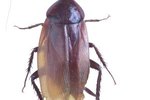
Finding termite droppings, or frass, around a building is never a good sign. Frass means an active termite infestation exists. Depending on the type of termites they are, it might not be long before they render your house or other building structurally unsound. Get an exterminator to your property as soon as you notice droppings.
Types of Termites
While drywood and subterranean termites physically resemble each other, they behave quite differently. In the United States, drywood termites are found in warm regions, while subterranean termites live throughout the country. Drywood termite colonies are much smaller than those of the subterraneans, numbering only a few thousand in population each. Subterranean termite colonies can contain 5 million to 10 million insects. Drywood termites create nests inside the structure they are consuming, whether it's a building, log or piece of furniture; subterranean termites nest in the ground. Serious structural damage takes longer to occur with a drywood infestation compared with the time it takes with a subterranean infestation. The latter consume wood up to 10 times faster.
Drywood Frass
Drywood termite droppings appear in different colors -- the type of wood determines the shade of the frass. However, these pellet-like droppings are always six-sided, left where the termites nest or consume wood. You might also spot "kick-out" holes in the wood consumed -- tiny holes specifically created to remove fecal material from their food source. In addition to the droppings, after a swarm, drywood termites shed their wings, leaving little bits of detritus with the frass. Only older, established colonies will swarm.
Subterranean Termites Droppings
Subterranean termites construct tunnels out of fecal material, soil and their saliva. These termites put those droppings to use to line their tunnels. Because the feces contain undigested wood, they make good construction material. Since these termites nest in the ground, they use these tunnels to travel to their food source. You'll usually find these tunnels around the foundation of a building. Unlike drywood termites, you won't find actual droppings, per se.
Removal
If you find any evidence of termite droppings, contact a pest control agency. Getting rid of these pests isn't a do-it-yourself project. An experienced exterminator assesses the damage and designs a termite eradication program for your particular situation. Depending on the extent of the infestation, spot treatment might do the trick, or your entire building might require fumigation. Licensed exterminators are knowledgeable about the regulations for pesticide use in your jurisdiction.
References
Photo Credits
-
Hemera Technologies/Photos.com/Getty Images
Writer Bio
Jane Meggitt has been a writer for more than 20 years. In addition to reporting for a major newspaper chain, she has been published in "Horse News," "Suburban Classic," "Hoof Beats," "Equine Journal" and other publications. She has a Bachelor of Arts in English from New York University and an Associate of Arts from the American Academy of Dramatics Arts, New York City.



